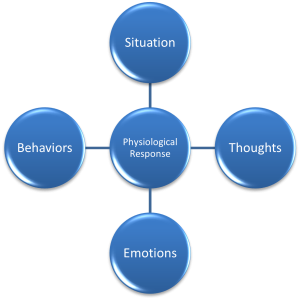Understanding Cognitive Behavior Therapy: Therapy That Works!
By: Sheila Allameh, Psy.D. | September 15, 2023

“Change your thoughts, and you change your world.” – Norman Vincent Peale
What is Cognitive Behavior Therapy?
Cognitive Behavior Therapy (CBT) is recognized as one of the most effective and popular forms of psychotherapy. More than 2,000 studies have examined the efficacy of CBT to treat a range of conditions including depression, anxiety, post-traumatic stress disorder (PTSD), sleep disorders, substance use, eating disorders, quality of life issues, headaches, and obesity.
The cognitive model (shown below) is the foundation of CBT, that illustrates the relationship between situations, thoughts, emotions, and behaviors, as well as one’s physiological response. A person’s thoughts are influenced by the situation, which in turn impacts how they feel and behave.

“It’s not the situations in our lives that cause distress, but rather our interpretations of those situations.” – Aaron T. Beck, M.D.
Techniques Used in Cognitive Behavior Therapy
1. Challenging Cognitive Distortions
Your therapist who specializes in CBT will help you identify errors in your thought patterns (also known as cognitive distortions), challenge the validity of these thoughts, and replace them with objective and data driven thoughts.
“Just because you think something, doesn’t necessarily mean it’s true.” – Judith Beck, Ph.D.
Examples of common thinking errors:
- All-or-none thinking: These thoughts include absolutes and extreme rules or categories. Words such as always, never, completely, totally, and perfectly are used.
Example: “If I’m not a total success, I’m always a failure.”
- Overgeneralization: These thoughts view a single negative event as an example of continuous, total, never-ending patterns, like when you draw big conclusions from small amounts of information.
Example: “Because I felt uncomfortable at the meeting, I don’t have what it takes to work here.”
- Discounting & Filtering – This way of thinking emphasizes negative events, and neglects or rejects positive experiences by saying they don’t count, or they don’t mean anything.
Example: “I did a good job on the project but that doesn’t mean I’m good at my job; I just got lucky.”
- Mind reading: When you believe what others are thinking about you without considering other possibilities.
Example: “They think that I don’t know what I’m doing.”
- Catastrophizing: These thoughts, also referred to as “worst-case-scenario” thinking, focus on the worst possible outcome, however unlikely, or to think that a situation is unbearable or impossible when it is simply uncomfortable.
Example: “I’ll be so upset; I won’t be able to function at all.”
- Emotional reasoning: When you make decisions and arguments based on how you feel.
Example: “I know I do a lot of things okay at work, but I still feel incompetent.”
- “Should” statements: These thoughts include rigid rules that you set for yourself and others that always apply no matter the circumstances.
Example: “I shouldn’t make any mistakes.”
- Personalization & Self-blame: When you assume that you are completely or directly responsible for a negative outcome.
Example: “My neighbor didn’t say hello to me because I did something to upset them.”
Learning how to identify exaggerated, erroneous, unhelpful, or unrealistic thought patterns can be a difficult process, but a worthwhile one! When we adopt more constructive ways of thinking, we can challenge our perceptions about ourselves, others, and our future.
2. Skills Training
Therapy using CBT also includes learning new skills such as anger management, assertive communication strategies, how to set boundaries, build empathy, regulate our nervous system, and rehearse ways to reduce relapse. Some CBT therapies incorporate mindfulness and relaxation exercises.
3. Goal Setting and Problem-Solving Strategies
During the course of CBT therapy, you will learn how to create goals and develop problem-solving strategies to cope with challenging situations. Therapy using CBT is action-oriented and focuses on changes that you can make to your thoughts and behaviors.
Benefits of Cognitive Behavior Therapy
The core components of treatment using CBT are to learn about your diagnosis, develop rapport with your therapist, establish goals, and select interventions that will improve your coping skills. It is also important to monitor your progress and reevaluate goals during treatment.
Your success in therapy depends on a high degree of trust and collaboration between you and your therapist. You will actively develop goals, clarify your values, and create action plans (i.e., homework assignments) that are culturally appropriate and tailored to your individual needs.
Therapy sessions using CBT can be provided in individual or group settings, in-person or via teletherapy. It is effective for children and adults, for a wide variety of problematic behaviors. It is the most widely practiced and well researched form of psychotherapy. CBT can also help you gain insight into problematic behaviors, decrease psychological distress, and improve your physical and emotional functioning. Treatment typically involves weekly 50-55-minute sessions for 8 to 12 weeks.
Resources and How to Find Help
Mental health awareness and treatment is more crucial than ever. If you, or someone you know might benefit from treatment using CBT, Contact Us to learn more about how therapy works and what to expect. San Diego Psychologists at Therapy Changes offer specialized services using action-oriented approaches and are here for you. You don’t have to suffer in silence, and you don’t have to go it alone.
Photo by Sebastien Gabriel on Unsplash



